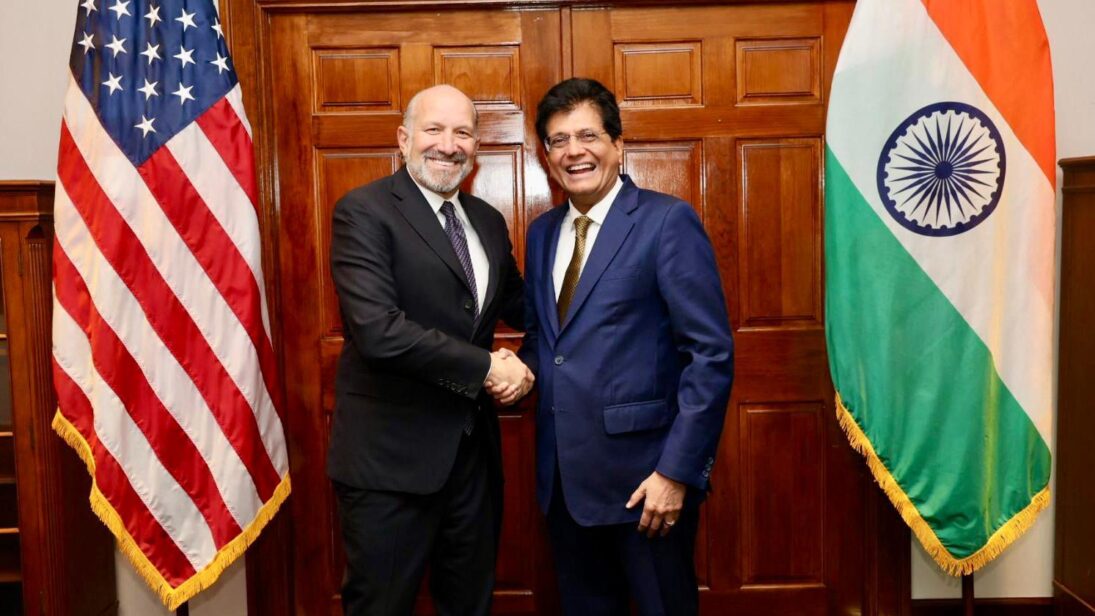
U.S. President Donald Trump’s decree of reciprocal tariffs on trading partners around the world has forced countries to revisit the implications of bilateral and free trade deals for their economic stability. India recognizes that to secure its economic future, it is imperative for New Delhi to ink deals with other complementary, competitive, and market-oriented economies, particularly in the West. Thus, Indian Foreign Minister S. Jaishankar has explicitly urged negotiators to focus on free trade agreements (FTAs) with the United States, the European Union, and the United Kingdom.
India and the United States are actively negotiating a bilateral trade agreement aimed at broadening their partnership on economic, trade, and defense issues. The first phase focuses on tariff reduction on industrial and agricultural products, and addressing non-tariff barriers and quality control specifications. The second phase intends to focus on a more comprehensive set of issues comprising 19 key areas, while the last phase would focus on finalizing the agreement and securing approvals from the U.S. Congress. Such a deal could promote collaboration in strategic sectors such as electric vehicles, semiconductor manufacturing, green technologies, and supply chain realignments. However, negotiators have yet to finalize the deal’s first phase, forcing a deadline extension to August 1, 2025.
A wide-ranging agreement that entirely concedes to U.S. demands could adversely impact India’s development imperatives such as food security, farmer welfare, and poverty alleviation and ensuring livelihood.
While there is substantial optimism for a bilateral trade agreement with the United States, some voices within the Indian policy sphere caution that the country needs to adopt a calibrated approach to a trade agreement with Washington. A wide-ranging agreement that entirely concedes to U.S. demands could adversely impact India’s development imperatives such as food security, farmer welfare, and poverty alleviation and ensuring livelihood. In its negotiations with the United States, India should be especially careful in three key areas—agriculture, intellectual property rights, and digital trade—that could have far-reaching socioeconomic implications throughout the country.
Agriculture Sector
Perhaps the most sensitive of the issues impacting Indo-U.S. negotiations is U.S. market access to India’s agricultural sector. Reducing import tariffs on American agriculture products such as dairy, maize, soybeans, poultry, and apples would give U.S. farmers better access to the Indian market. However, some fear that this may impact the economic security of those who depend on India’s agriculture sector, which supports over 700 million people, or nearly half the country’s population.
India’s agriculture sector is highly unorganized, characterized by fragmented landholding and a vast number of small and marginal farmers. Despite being the largest employment generating sector, it contributes only around 18 percent to India’s Gross Domestic Product. In comparison, the U.S. agriculture sector is organized, subsidized, capital-intensive, and export oriented. Opening up the agricultural market to U.S. goods could expose the Indian agriculture sector to a high degree of import competition for agricultural products, for which domestic producers have yet to achieve scale, price competitiveness, or technological depth. This could also lead to nationwide protests. For instance, during negotiations over the Regional Comprehensive Economic Partnership Agreement (RCEP), dairy farmers and milk vendors sent letters in hundreds of thousands to Prime Minister Narendra Modi, stating that India should not sign the deal. Given the complex domestic political economy of the agriculture sector and its propensity to shape electoral outcomes, policymakers should be cognizant of dramatic shifts in trade policy.
Intellectual Property Rights
Second, India must thoughtfully consider U.S. demands for strict intellectual property (IP) rights provisions. The Office of the United States Trade Representative reported in 2025 that India was on the “priority watch list” for inadequate intellectual rights protection and enforcement. Strict IP provisions under a trade agreement with the United States while otherwise offering predictability would create stronger protections for patented drugs made by U.S. pharma giants, which could risk dismantling India’s domestic generic pharmaceutical industry as a whole. The Indian generic medicine industry has played a pivotal role in providing affordable access to medicines for millions of people in the country and beyond, particularly as a leading producer and supplier of drugs to the United States, United Kingdom, European Union, and Africa. The demolition of this industry could pose a serious public health crisis.
The growth and development of India’s generic pharmaceutical industry is largely supported by several public interest provisions enshrined in Section 3 (d) of the Indian Patent Act 1970. These provisions actively inhibit American pharmaceutical giants from pushing the evergreening of patents to enhance their market access.

Digital Trade
Third, digital trade remains an area of high contestation given its economic and strategic importance. The United States has a strong interest in pushing for liberalized digital trade policies and has previously negotiated the liberalization of rules related to data localization, cross-border data flows, open-source code, and the elimination of customs duties on digital products. These rules are not aligned with India’s position, which is more conservative on digital trade in both multilateral and bilateral agreements. The India-United Arab Emirates Comprehensive Economic Partnership Agreement, for instance, states that the commitments on digital trade only reflect the two countries’ “best endeavor” and do not constitute a binding commitment. Many Indian analysts are concerned that the United States would make this language stronger. For example, the United States may ask India under the bilateral trade deal to transit from its existing “best endeavor clause” to a “binding clause” on the use of government data and treatment of digital products and data localization.
If it concedes to Washington’s demands on digital trade, New Delhi would surrender its ability to formulate policies for the development of domestic digital platforms and networks. Regulatory policies mandating data localization are critical to compel global tech companies to invest in the development of domestic data centers, servers, and data infrastructure. Likewise, restrictions on cross-border data flows are intended to help the country develop domestic digital firms, platforms, and vendors, given that foreign tech firms have historically enjoyed a larger market share in the Indian digital market, particularly in e-commerce and ridesharing.
In the absence of regulatory controls on cross-border data flows, there exists a potential risk of global big tech firms leveraging domestic data for anti-competitive purposes. This would allow foreign firms to monopolize access to domestic consumer data for market segmentation and targeted marketing, thereby outpacing Indian firms.
India needs to ensure that a trade deal with the United States does not undermine its policy sovereignty in the imposition of restrictions on cross-border data flows, server localization, customs duties on digital products, and open-source code. An unfavorable deal may curtail the government’s agency to create regulatory measures for data, as it is yet to develop domestic digital rules in the ever-evolving global digital economy. Digital trade commitments through an agreement with the United States could limit India’s ability to pursue digital catch-up policies in a manner that supports the development of domestic digital firms and platforms. Thus, New Delhi would have to carefully balance sovereignty considerations with economic benefits in concluding this deal.
What Can India Get from a U.S. Deal?
Despite several challenges, India can potentially benefit from a bilateral trade agreement with the United States. New Delhi stands to gain from the current tariff realignment in Washington, particularly as most Southeast Asian economies face much higher tariffs. India has the potential to replace China and Singapore in the chemical sector, including pharmaceuticals, because the latter countries face higher import tariffs. India has also revealed a comparative cost advantage in low and high value-add sectors, such as apparel, textiles, leather, nuclear equipment, electronics, and vehicles. Overall, the current U.S. tariff framework seems to provide an edge to Indian manufacturers against their competitors in countries like China, Bangladesh, Vietnam, and Mexico.
New Delhi would have to carefully balance sovereignty considerations with economic benefits in concluding this deal.
However, at the same time, Indian policymakers need to be cautious of a comprehensive trade agreement with the United States, given President Trump’s idiosyncratic trade policy stance. Furthermore, they should carefully review U.S. trade talks with its key partners—particularly, Japan, Indonesia, Cambodia, Malaysia, Australia, the European Union, and Canada—and their respective positions in politically sensitive sectors such as agriculture, since most trading partners are reluctant to open their domestic markets.
The only option at this juncture for India may be to move ahead with a mini-trade deal, focusing on industrial products, non-tariff barriers, defense, oil and gas, and certain non-sensitive agricultural products.
While deepening economic ties with the United States may appear strategically sound, India must remain vigilant in protecting its domestic priorities. Trade agreements of this scale are not simply economic arrangements but deals that have far-reaching development implications. It is imperative for Indian policymakers to understand that a trade agreement with the United States—altering policy norms for agriculture, intellectual property rights and pharmaceutical accessibility, and digital trade sovereignty—could jeopardize the country. Instead, India should cautiously and deftly negotiate a framework that ensures reciprocity without eroding its policy sovereignty and socioeconomic foundations.
Views expressed are the author’s own and do not necessarily reflect the positions of South Asian Voices, the Stimson Center, or our supporters.
Also Read: Elevating India’s Agricultural Diplomacy for Global Food Security
***
Image 1: Piyush Goyal via X.
Image 2: Via The White House.


